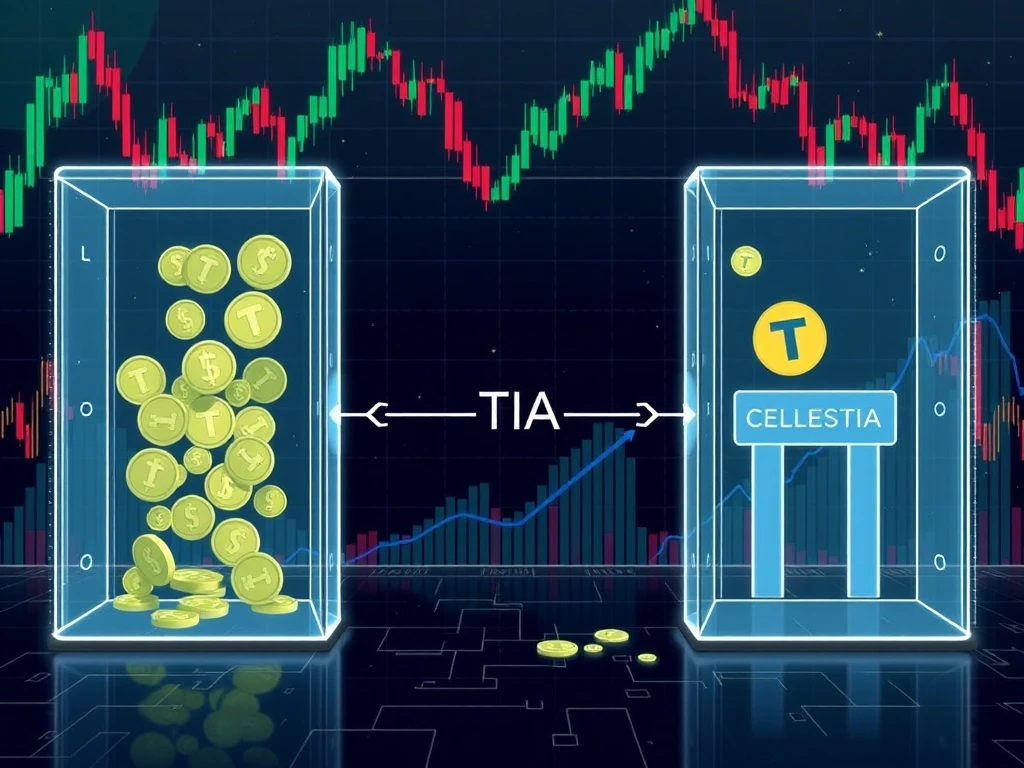Polychain Capital’s Strategic Exit: Unveiling the $62.5M Celestia (TIA) Stake Divestment and its Crypto Market Impact

The cryptocurrency world is abuzz with the recent monumental move by Polychain Capital, a titan in the blockchain investment space. In a development that has sent ripples across the crypto market, Polychain has successfully divested its substantial $62.5 million stake in the Celestia blockchain, marking a complete exit from its staked holdings. This isn’t just another transaction; it’s a meticulously executed phased unlock, signaling a significant strategic shift for institutional players and setting new precedents for token distribution within the Celestia ecosystem.
What Triggered Polychain Capital’s Strategic Exit?
On July 24, 2025, Polychain Capital finalized the sale of 43.45 million TIA tokens to the Celestia Foundation. This isn’t a hasty retreat but a calculated maneuver. Polychain, a prominent venture capital firm known for its deep involvement in decentralized finance (DeFi) and modular blockchain projects, has historically held significant stakes in layer-2 networks. Their decision to fully divest their TIA position is rooted in a recalibration of risk, particularly ahead of anticipated changes to Celestia’s staking incentives. This strategic pivot highlights a broader industry trend where major investors are reassessing their exposure and aligning with evolving governance and reward models.
The Mechanics of the $62.5M Celestia (TIA) Token Transfer
The sheer scale of this transaction — involving 43.45 million TIA tokens valued at $62.5 million — necessitated a sophisticated approach to avoid undue market disruption. The sale was executed via a phased unlock mechanism, designed specifically to mitigate market volatility. Instead of a single, large dump, the tokens were transferred gradually to the Celestia Foundation. This careful approach is crucial for maintaining stability in the crypto market, especially for a project like Celestia which relies on robust tokenomics.
- Phased Unlock: A pre-planned schedule for releasing tokens, preventing a sudden influx that could crash prices. This mechanism demonstrates a commitment to market health.
- Buyer: The Celestia Foundation itself, absorbing a major validator’s stake directly into its treasury. This move strengthens the foundation’s control over its native token.
- Purpose: To manage liquidity and ensure market stability, while restructuring token distribution. It’s a proactive measure to prevent large sales from negatively impacting the TIA token’s value.
- Future Distribution: The Foundation plans to distribute these acquired TIA tokens to new investors through a rolling schedule, further aiming to manage market impact and broaden token ownership. This could lead to a more decentralized distribution over time.
Impact on Celestia’s Governance and the Broader Blockchain Investment Landscape
Polychain’s exit and the Celestia Foundation’s acquisition have profound implications for Celestia’s future governance. With the Foundation now holding a significantly increased treasury of TIA tokens, its influence over governance decisions is poised to amplify. While specific plans for utilizing these tokens remain unannounced, the potential for increased ecosystem funding or developer grants is a major talking point among analysts.
- Centralized Influence? The transfer shifts power from a major financial stakeholder (Polychain) to the project’s foundation. This could reinforce the foundation’s authority in decision-making, raising questions about the balance between centralized control and decentralized governance principles.
- Ecosystem Development: An expanded treasury could mean more resources for building out the Celestia ecosystem, attracting more developers, and funding crucial initiatives. This is a potential benefit for the entire Celestia community.
- Market Stability: While large institutional sales can initially cause short-term price volatility, historical trends suggest that markets often stabilize as governance structures adjust and new investors enter. The phased unlock mechanism was key to managing this, demonstrating a mature approach to blockchain investment.
This event underscores a growing trend within the broader blockchain investment sector. Institutional players are increasingly adopting measured strategies to align with shifting incentives and refine economic models, particularly within modular blockchain projects like Celestia. The absence of specific regulatory updates in this transaction, adhering to Celestia’s standard token management framework, further highlights a focus on internal protocol governance rather than external compliance measures.
What Does This Mean for the Future of TIA Token and Crypto Market Dynamics?
The market’s reaction to this substantial sale has been a mix of caution and optimism. While some view it as a neutral event, a simple change of hands, others are keen to see how the Celestia Foundation will leverage its newly acquired assets. The timing of Polychain’s departure coincides with Celestia’s impending staking reward adjustments, suggesting a calculated move to capitalize on favorable market conditions ahead of potential volatility linked to protocol upgrades. This strategic foresight by Polychain Capital offers a glimpse into how sophisticated investors navigate the dynamic crypto market.
- Strategic Exits are Normal: Large institutional exits, when managed transparently and via phased unlocks, are often a sign of market maturity rather than a red flag. They allow capital to rotate and new investors to enter.
- Foundation’s Role: Pay close attention to how the Celestia Foundation announces its plans for the acquired TIA tokens. This will be a strong indicator of future ecosystem direction and potential growth for the TIA token.
- Governance Shifts: The balance of power in blockchain governance is continually evolving. Understanding who holds the majority of tokens, and their intentions, is crucial for assessing project health and future stability.
Polychain Capital’s divestment of its $62.5 million Celestia stake is a landmark event in the blockchain investment landscape. It exemplifies the evolving relationship between institutional investors and decentralized projects, highlighting strategic recalibration in response to changing market dynamics and governance models. As the Celestia Foundation takes the reins of this significant TIA token holding, the crypto market will be watching closely to see how this strategic shift shapes Celestia’s future and influences the broader narrative of institutional engagement in the modular blockchain space. This move sets a precedent for how large stakeholders can exit gracefully, ensuring market stability while empowering project foundations.
Frequently Asked Questions (FAQs)
1. What was the value of Polychain Capital’s Celestia stake sold?
Polychain Capital sold its stake in Celestia for $62.5 million, which represented 43.45 million TIA tokens.
2. Who acquired Polychain Capital’s TIA tokens?
The Celestia Foundation acquired the 43.45 million TIA tokens from Polychain Capital.
3. Why did Polychain Capital sell its Celestia stake?
Polychain Capital’s decision to divest was a strategic recalibration of risk, aligning with broader industry shifts and anticipating changes to Celestia’s staking incentives. It marked a full exit from their staked holdings.
4. How did the Celestia Foundation acquire the tokens without causing market disruption?
The acquisition was completed through a phased unlock mechanism, designed to mitigate market volatility by gradually transferring the tokens rather than a single large transaction.
5. What are the potential implications of this sale for Celestia’s governance?
The Celestia Foundation’s increased treasury holdings could amplify its influence over governance decisions, potentially leading to greater ecosystem funding or developer grants. It shifts power from a major financial stakeholder to the project’s foundation.
6. When did this transaction take place?
The transaction was finalized on July 24, 2025.










